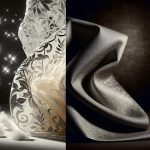I've always found the comparison between chiffon and organza pretty intriguing. Both fabrics have their unique charm, don't they? Chiffon offers that soft, flowy elegance that's perfect for breezy dresses, while organza brings a stiffer, shinier quality that screams high fashion. But when you really look at them, they're as different as can be when it comes to texture and use. It's like comparing a delicate whisper to a bold statement. I'm curious, though, how do you guys see these fabrics? Have you noticed other differences that really stand out or certain qualities that might make one better than the other for specific situations?
Table of Contents
Key Takeaways
- Chiffon and organza differ in texture; chiffon is soft and flowing, while organza is crisp and structured.
- Both fabrics are traditionally silk-based but have synthetic options available for affordability.
- Chiffon has a muted transparency that allows more light to pass through, unlike the crisp transparency of organza.
- Chiffon is prone to snagging and fading, whereas organza is more durable and maintains its color better.
- While both are used in bridal wear for their lightweight and aesthetic appeal, their textural contrasts cater to different design needs.
Understanding Chiffon
Chiffon is a lightweight, sheer fabric known for its soft drape and elegant appearance. Its journey begins over a century ago, originating as a silk fabric. The name itself, derived from the French word for 'cloth,' hints at its prestigious beginnings. Traditionally, chiffon was exclusively made from silk, making it a luxury item. However, as technology advanced, synthetic fibers like polyester began to replicate its qualities, making chiffon more accessible and versatile.
Chiffon's unique weaving process, which twists yarns alternately, results in a slight puckering effect in different directions. This gives chiffon its slight stretch and its well-known flowing appearance. When it comes to dyeing, chiffon can be a bit tricky due to its light and airy nature. Silk chiffon, being a natural fiber, takes on dyes beautifully, allowing rich and vibrant colors. Synthetic chiffon is also dyeable, but the process varies slightly to guarantee color fastness and to maintain the fabric's integrity.
Whether it's creating flowing evening gowns, elegant scarves, or sheer curtains, mastering chiffon's characteristics can transform how it's used in both fashion and décor. Understanding its history and handling requirements allows designers and fabric enthusiasts to fully appreciate and utilize chiffon in their creative endeavors.
Exploring Organza
So, what exactly is organza? Let's dive right in. Organza is a fine, sheer fabric that's known for its crisp drape and shimmering appearance. Traditionally made from silk, it holds a sense of luxury and a lightweight texture that's hard to ignore. It's fascinating to explore its roots—organza originates from the traditional silk weaving techniques of East Asia, particularly China. This historical context isn't just a cool fact; it explains the fabric's enduring prestige and widespread use in high fashion.
Now, let's talk color variations, because organza really shines here. This fabric isn't shy about showing off in a variety of hues. From soft pastels to deep, rich tones, organza can adapt to nearly any color palette. Its ability to be dyed in a myriad of shades makes it incredibly versatile for designers who want to play with light and layering. The colors in organza look exceptionally vibrant due to its semi-transparent nature, which adds depth and an almost ethereal quality to gowns, scarves, and other garments.
Fiber Content Comparison
While organza is traditionally silk-based, let's now explore how the fiber content of chiffon differs. Chiffon can be made from silk like organza, but it's often crafted from synthetic fibers such as polyester or nylon. This diversity in material origin plays a significant role in both the texture and the production costs of chiffon compared to organza.
Chiffon's ability to blend synthetic materials not only makes it more versatile but often more affordable. These synthetic fibers lower production costs and provide durability which silk alone might not offer. On the other hand, silk chiffon remains at the higher end of the market, prized for its finer feel and traditional appeal.
Here's a quick breakdown in a table format to clarify the differences in material origin and impact on production cost:
| Material Used | Production Cost Implications |
|---|---|
| Silk | Higher cost, luxurious feel |
| Polyester | Lower cost, durable |
| Nylon | Lower cost, slightly less durable than polyester |
Understanding these nuances helps us appreciate why chiffon might be chosen over organza for certain applications, despite their visual similarities. It's all about finding the right balance between cost, functionality, and aesthetic appeal.
Textural Differences
Let's explore how the textures of chiffon and organza differ from each other. First off, when you run your fingers across a piece of chiffon, you'll notice it's remarkably soft and supple. This fabric has a slight give, which makes it feel gentle and flowing. It's this texture that allows chiffon to drape so beautifully, making it a favorite for flowy dresses and scarves.
On the flip side, organza presents a stark contrast in feel perception. It's crisp and stiffer, often creating a slightly scratchy sensation against the skin. This stiffness, however, gives organza its unique structure, perfect for bolder, stand-out pieces like puff sleeves and structured gowns.
Color variation also plays a role in how we perceive texture. Chiffon, with its translucent appearance, tends to soften colors, giving them a muted, ethereal quality. Organza, meanwhile, due to its denser weave, reflects light more intensely, making colors appear brighter and more vibrant. This can enhance the perceived crispness of the fabric.
Understanding these textural nuances helps in selecting the right fabric for your project, ensuring the feel aligns with the desired function and aesthetic.
Weaving Techniques
Now, let's talk about how these fabrics are made.
Chiffon and organza each have unique weaving processes that give them their special qualities.
I'll explain how the chiffon weaving process differs from the creation of organza fabric.
Chiffon Weaving Process
Chiffon is crafted through a meticulous weaving process that uses fine, twisted yarns to create its characteristic soft and sheer texture. When I'm weaving chiffon, the thread count and loom type are essential.
High thread counts guarantee the fabric's luxurious feel, while the choice of loom—whether a plain weave on a traditional loom or a more modern air-jet loom—impacts how tightly those threads are interlaced. The yarns themselves are often synthetic fibers like polyester or natural ones such as silk.
Each requires specific settings on the loom to maintain the delicate balance between strength and the soft, airy quality we love in chiffon. Mastering this balance is key to producing excellent chiffon that drapes beautifully.
Organza Fabric Creation
While chiffon uses a softer, more flowing weaving technique, organza is created with a stiffer finish owing to its unique weaving style. This difference is important in how these fabrics feel and behave. Let's explore how organza's creation sets it apart.
- Plain Weave Technique: Organza utilizes a plain weave, which is simple yet effective for achieving its crispness.
- High-Twist Yarns: The use of high-twist yarns in both warp and weft adds to the fabric's tensile strength.
- Stiff Finish: A finish that enhances its sheer, yet structured appearance.
- Fabric Origins: Traditionally made from silk, modern varieties include synthetic fibers.
- Production Locations: Major production hubs include China, India, and Italy, each adding a unique touch to the fabric's quality.
This weaving method gives organza its renowned body and transparency, ideal for various high-fashion applications.
Transparency Levels
Now, let's talk about how see-through these fabrics are.
We'll look at their sheer qualities, see how clearly you can see through each, and compare how much light each lets through.
It's all about figuring out just how transparent chiffon and organza really are.
Comparing Sheer Qualities
Exploring the distinct qualities of fabrics, I find that chiffon and organza differ significantly in their transparency levels.
Chiffon, with its sheer popularity, is often softer and shows a subtle transparency that hints at what lies beneath without revealing too much. It drapes beautifully, conforming to the body's silhouette.
Organza is stiffer, offering a more structured form while still maintaining a high level of transparency.
- Chiffon is softer, enhancing its fabric drapability.
- Organza holds its shape better, ideal for more structured designs.
- Chiffon subtly blurs what's behind it, providing a delicate allure.
- Organza offers a crisp sheer quality, almost glass-like.
- Both fabrics are popular in fashion for their unique textural qualities and aesthetic appeal.
Visual Clarity Differences
Building on their textural differences, let's examine how chiffon and organza vary in their transparency levels. Chiffon offers a muted transparency that subtly distorts color perception, making it ideal for softening the appearance of vibrant hues. This quality also impacts pattern visibility, often blurring the sharpness of designs beneath it, lending a dreamy, ethereal quality to garments.
In contrast, organza stands out due to its crisp transparency. This characteristic enhances color perception, making colors appear more vivid and patterns more defined. The clear visibility through organza means that it doesn't just show what's underneath; it accentuates it, making this fabric perfect for fashion where bold visual impact is desired.
Both fabrics, hence, play uniquely distinct roles in textile design.
Light Penetration Comparison
Let's explore how chiffon and organza differ in their light penetration qualities. When it comes to transparency, both fabrics have unique characteristics influenced by their weave and fiber content, but they handle light differently due to their texture and finish.
- Chiffon: Softer and more translucent, allowing more light to pass through, which enhances its delicate appearance.
- Organza: Crisper and stiffer, with a sheer quality that reflects light uniquely, creating a subtle shimmer.
- Color influence: Lighter colors in both fabrics tend to be more transparent, while darker shades add a level of opacity.
- Reflective properties: Organza's slightly reflective surface can alter the perception of color under different lighting conditions.
- Fabric texture: Finer weaves in chiffon allow for higher light penetration compared to the denser weave of organza.
Durability and Maintenance
When considering durability and maintenance, chiffon generally requires more careful handling than organza. That's because chiffon is more delicate and prone to snagging and tearing, especially compared to the sturdier, more structured organza. I've found that organza holds up better against everyday wear and tear, which is something to keep in mind if you're deciding between the two for an outfit or project.
In terms of keeping them looking their best, both fabrics present unique challenges. Chiffon, for instance, isn't great at stain resistance. If you spill something on chiffon, it can be a real hassle to get it out without damaging the fabric. Color retention is another point where chiffon can be a bit sensitive. It tends to fade quicker than organza, especially if it's frequently washed or exposed to sunlight.
Organza, on the other hand, is slightly more forgiving. It's not only better at resisting stains but also maintains its color better over time. However, both fabrics require gentle washing and should ideally be dry cleaned. I always recommend reading the care label and following those instructions to the letter to keep these fabrics in pristine condition.
Common Uses in Fashion
Now, let's talk about how chiffon and organza are used in fashion.
These fabrics are staples for bridal gowns and evening wear. Each material brings a unique touch to these elegant outfits, highlighting their distinct qualities.
Bridal Gown Fabrics
Bridal gowns often feature luxurious fabrics like chiffon and organza, each chosen for their unique textures and effects. When I'm considering these materials for bridal designs, I focus on their ability to blend elegance with practicality. Here's why they're top picks:
- Fabric Sustainability: Both fabrics offer options in sustainable fibers, which appeal to eco-conscious brides.
- Color Variety: They're available in a wide range of colors, ensuring that every bride finds her perfect shade.
- Lightweight Feel: Ideal for layered gowns without the bulk.
- Elegant Draping: They flow beautifully, creating a dreamy silhouette.
- Photogenic Qualities: Both chiffon and organza catch light wonderfully, making them favorites for photographers.
Choosing the right fabric can truly define a bridal gown's character.
Evening Wear Choices
I often choose chiffon and organza for evening wear due to their versatility and elegance. Both fabrics play well with the latest color trends, helping me maintain a stylish appearance while enjoying their timeless appeal. Chiffon's light, flowing quality makes it ideal for fabric draping, creating soft, ethereal silhouettes that move beautifully. It's perfect for those who love a graceful, floating look in their outfits.
Organza, on the other hand, holds its shape better, offering a crisper form that's fantastic for more structured designs. This difference means I can use organza when I want to highlight stronger lines or add a bit of drama with sheer layers that catch the light uniquely. Both fabrics make sure my evening look is always on point.
Choosing Between Chiffon and Organza
When deciding between chiffon and organza, consider the feel and flow you're aiming for in your fabric choice. Chiffon is famously flowy, making it ideal for garments that need to drape softly. Organza, on the other hand, holds its shape with a crisp texture, perfect for more structured designs. It's important to weigh these characteristics against the intended use of your garment.
Here's a quick guide to help you choose:
- Fabric cost: Chiffon generally tends to be less expensive than organza. This could be a deciding factor if you're working within a budget.
- Color availability: Both fabrics come in a wide range of colors. However, organza's stiffer texture can make vibrant colors stand out more, giving a richer appearance.
- Drape: Chiffon drapes beautifully and softly, ideal for flowing dresses. Organza is stiffer, great for adding volume and shape.
- Occasion: Consider the event. Chiffon is perfect for a breezy, romantic look suitable for evening wear. Organza's structure makes it fantastic for formal attire.
- Sewing ease: Chiffon can be challenging to sew due to its lightness and slipperiness; organza is somewhat easier to handle due to its stiffness.
Choosing the right fabric really depends on what you're after in your final piece.
Care Instructions
Caring for chiffon and organza requires specific techniques to maintain their unique textures and appearances. When it comes to washing temperatures, it's important to keep them low. I've found that both fabrics do best when hand washed in cold water. Hot water can cause shrinking and alter their delicate structure, so I always stick to around 30°C (86°F). For machine wash enthusiasts, a gentle cycle with a mesh bag is a safe bet to avoid snags and tears.
Stain removal is another area where I tread carefully. I never scrub vigorously as it can damage the fibers. Instead, I blot stains gently using a mild detergent. Patience is key here. For tougher stains, soaking in a mixture of water and a bit of detergent before washing helps lift the stain without the need for harsh chemicals.
Drying is straightforward—never wring out these fabrics. I lay them flat or hang them up to air dry, away from direct sunlight to prevent fading. Ironing should be done at a low temperature, and I always use a pressing cloth to protect the fabric. By mastering these care techniques, I make sure my chiffon and organza pieces stay pristine and fabulous.
Frequently Asked Questions
Can Chiffon or Organza Be Dyed at Home?
Yes, I've successfully dyed both fabrics at home. Key steps include proper fabric preparation and choosing the right dyeing techniques. It's essential to follow specific guidelines to achieve vibrant, even colors.
Are Chiffon and Organza Hypoallergenic?
I've checked, and neither chiffon nor organza are inherently hypoallergenic. If you've got fabric allergies or material sensitivity, these fabrics might trigger a reaction, especially if they're processed with certain chemicals.
Do Chiffon and Organza Shrink After Washing?
Chiffon and organza can shrink if you're not careful with the washing methods. I've found that gentle, cool washes minimize shrinkage factors. Always check the care label before tossing them in the wash.
How Does Humidity Affect Chiffon and Organza?
Humidity impacts how chiffon and organza handle fabric absorption and climate resilience. I've noticed these fabrics can absorb moisture, affecting their drape and feel, especially in high humidity environments.
Are Chiffon and Organza Fabrics Sustainable?
I'm not sure if chiffon and organza are sustainable. Their production impacts the environment to a large extent. However, advancements in fabric recycling might help reduce that footprint if properly implemented in the industry.
- Nomex Fabric Colors: A Guide to Black, White, Blue, and Other Hues - June 22, 2025
- Working With Nomex Fabric: Can You Dye, Soften, or Patch It? - June 22, 2025
- Technical Nomex Explained: Trilaminates (CPC, PTFE) and Spunlace Fabrics - June 22, 2025







